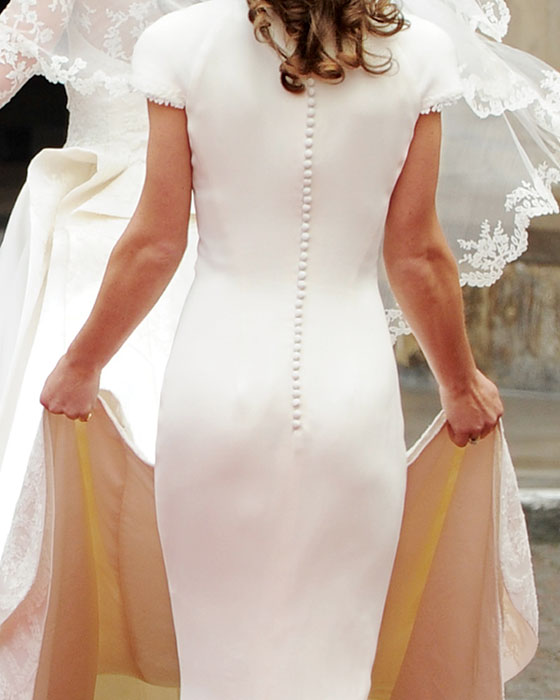 |
(Photo: Carl de Souza/AFP/Getty Images ) |
The week of William and Kate’s wedding, I went along to Rules, London’s oldest restaurant, a red velvet fantasia of old Union Jacks and mounted stags’ heads. Rules has a sense of tradition and romantic secrecy that can seem, on a warm spring evening, as bold as the restaurant’s polished brass. Charles Dickens drank his share here, and so did that frisky little Edward VII, who was forever sneaking the actress Lillie Langtry into the upstairs bar. Rules was always happy to bend the rules for royalty, and you can still see a secret door installed for Lillie’s quick exits when called upon to canoodle with the king.
For William and Kate, Rules was offering a new house cocktail on its menu, “Kate Middleton’s ‘Royal 29,’ ” which comes rather blue and racy in a short martini glass: “Tanqueray gin, Pinky vodka, Lillet, crystallised violet & rose petals, with a squeeze of lemon,” yours for £12 and a wink at the waiter. “When are you doing a Pippa cocktail?” someone asked the bartender. “Oh, soon,” he said. “Soon we will have the Pippa. Except we will call this the ‘Pippa 69,’ ” he said, leering. “You’re a dirtbag,” I told him. “I know,” he said in a bright Spanish accent. “She dirty.”
Rules has always been a good place to go to find out whom the nation fancies, even if one gets a quite different picture of the country these days from the riots in Tottenham and Croydon. Here, everyone has been talking about Pippa Middleton, the sister of the bride, who stole the show at the royal wedding in a manner that most ordinary sisters would find unforgivable. Kate’s dress, by Sarah Burton for Alexander McQueen, was greatly admired on the day, but it was the rear at the rear that came out of the wedding its true heroine and passion topic numero uno. It was instantly named the shapeliest bottom in the kingdom. And the proprietor of that derrière? “She’s just the national babe.”
Pippa Middleton is not like your traditional fringe royal: Most members of “the firm,” as insiders call the extended family, are mothballed for years, disdainful of the limelight. Pippa is more like a contestant on a television talent or reality show. She turned up in the right dress. She has a nice face. And the story would end there—with howls of approval from Simon Cowell and with a hundred million sighs of “It could have been me”—were it not for the fact that Pippa’s lovely transparency is a window into a world of influence, and affluence as influence, a place where money and class meet fashion and retail and modern manners. All spring and summer, Pippa has been a tabloid sensation, selling newspapers like no one since Diana. And what the tabloids have dreamed up is a modern mystery play about how an ordinary girl can come to occupy the upper reaches of the aristocracy.
But above all, this is a fashion story. I mean: It’s a story about clothes, about what these people wear and what others wear as a result of what they wear. The Middletons and their set might love the grouse moors and Floors Castle, the charity balls and the slopes of St. Moritz, but unlike Diana, Princess of Wales, they promenade through those places in ways that can be understood by high-street retail—understood and monetized. Diana was good with the tabloids, cultivating single reporters and crying on their shoulders, but the Middletons use the press to create a commercial buzz, aiding British fashion but also building the image of themselves as style-makers. Kate Middleton, now the Duchess of Cambridge, is said to have details of the outfits she is wearing every day leaked to the Daily Mail, the voice of “Middle England” and a seasoned vehicle for middle-class lust and prejudice. Kate once worked as an accessories buyer for the high-street clothing company Jigsaw—its founders, Bella and John Robinson, were guests at her wedding—and she has an instinct for what girls without large incomes can do to look nice. She knows where they must go: Jigsaw, Reiss, Whistles, L. K. Bennett (for shoes), and Hobbs, and has made herself an ambassador for these places much as Michelle Obama emerged as a smart-but-casual rabble-rouser for the virtues of J.Crew.
It was not always thus. I saw the queen once, when I was 10 years old and a Boy Scout, and she appeared like an explosion of lavender, with a matching hat and her feet crushed into grannyish shoes. For years, she has dressed like her mother, in pastel-colored suits by Norman Hartnell, and her daughter, Princess Anne, followed the same pattern, literally, wearing clothes you suspected were designed to look frumpy and sickly sweet, with a string of pearls and tan tights. This was fragrant mausoleum clothing. Then Diana came along with her Eighties Eurotrash Chic: The shoulders were padded, the lapels were diamanté, the collars were stiff and military, and the hats were St.-Tropez-ish, but Diana, at least, connected with aspirations to sexyhood. And yet, in the burgeoning early period of Galliano and Westwood, Diana stuck to Oscar de la Renta. Her idea of a hot British designer was probably Jasper Conran.

